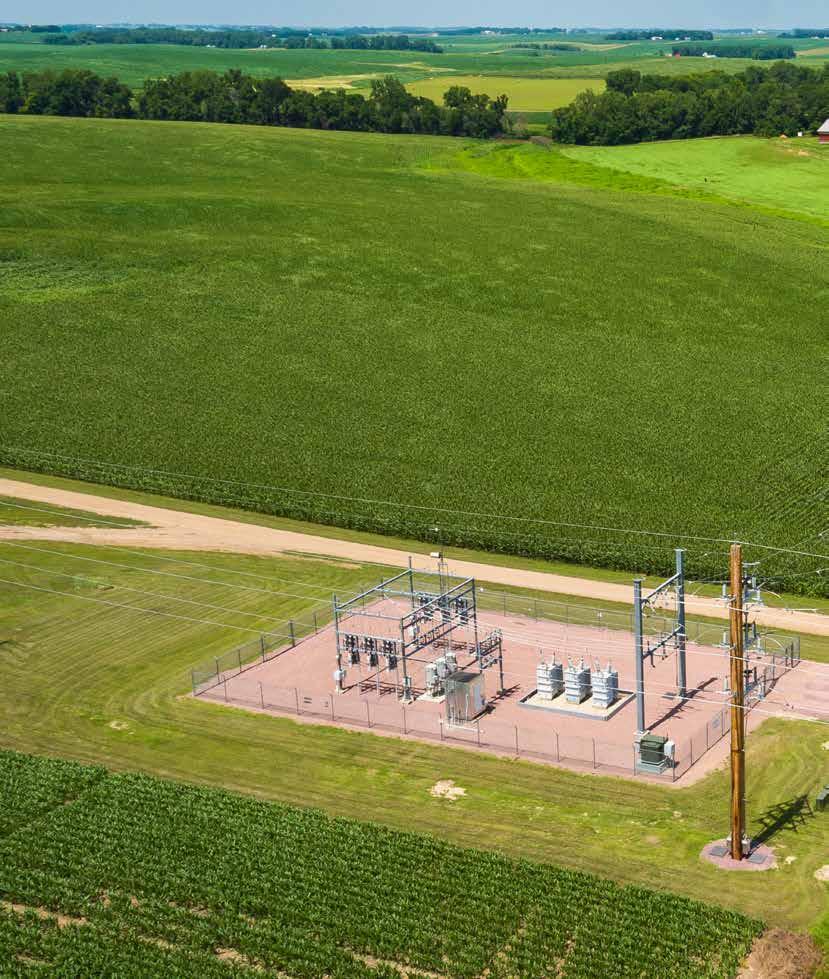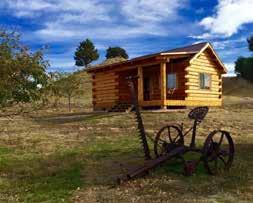
9 minute read
Off-Grid Opportunities
Smaller, grid-tied solar energy systems can start around $5,000, depending on the goals and purpose.
By Tamara Choat L iving off the grid may sound romantic and environmental- ly friendly – the perfect set- ting for an HGTV show.

For some ranchers, it’s their only option.
In remote areas where power is not available or feasible, life without an electric bill – and the conveniences of power – has been a way of life for generations. For those original off-gridders, as well as landowners who are building new operations on remote land – or simply looking at alternative energy – the cost of solar power has become highly competitive.
Buddi Waddington is familiar with off-grid solar systems. The ranch his family owned north of Custer, Mont., was several miles from electric power lines, so he, his parents and his brother’s family all utilized solar energy systems to power their three homes and ranch operation. The main system at the ranch headquarters consisted of a free-standing 36-panel solar rack and a separate utility building to house the remaining components. This system could handle a 220-volt system and powered an average-sized house, mobile home, barn, shop and indoor riding arena, and included a 15,000-E#AZW4`kilowatt diesel generator for backup.
“It really powered a lot, but bigger things like the welder we would have to turn the generator on for,” he says. ed. He said his parents were able to operate a microwave on their system and it ran – it just didn’t work as well.
Waddington, who has since moved to Abilene, Texas, says it would have cost about $100,000 to bring utility lines in to their main location; it cost them about $30,000 to improve on the existing solar panel system.
Waddington’s solar system at his home 10 miles away was smaller; a 110v system that powered a small house and water pump. He estimates it cost about $13,000 to put in place. “It wasn’t the same as being on regular power – there were small adaptations we made like lower watt light bulbs, but for the most part, they were minor adjustments,” he says. He ran a 110v propane clothes dryer and would supplement the furnace with the generator if need
At both places the Waddingtons had water cisterns on nearby hills, using solar power to fill and gravity flow to disperse when needed.
Even with their relatively advanced systems, Waddington said he still had ongoing costs. “I tell people you pay what equates to a monthly bill, it just comes in larger increments over a longer period of time.” He estimates with the 16 batteries in his system that need to be replaced about every seven years, and the costs of running a 6,000- watt propane generator in the winter, he paid an average of $100-$150 a month.

Solar energy can be a fit for residential, commercial or off-grid sites.

The sunny days of the arid, upper Midwest make great locations for solar panels.

- Country Quiet - Big City Access -
Located 3+ hours from Denver near the North Platte River, Fort Laramie National Historic Site is just minutes away. Property consists of 292+ acres of hills, trees and fenced quality pasture. Corrals with stock shed. Improvements: 2300 sq ft home, detached garage, 40x40 Heated Shop, 60x40 Insulated RV/Vehicle Barn with 14 ft overhead door. 1200 sq ft Guest Quarters plus a 480 sq ft Log Bunk House. Diamond B Realty 2309 West C St. Torrington, WY 307.532.1717
Located 3+ hours from Denver near the North Platte River, Fort Laramie National Historic Site is just minutes away. Property consists of 292+ acres of hills, trees and fenced quality pasture. Corrals with stock shed. Improvements: 2300 sq ft home, detached garage, 40x40 Heated Shop, 60x40 Insulated RV/Vehicle Barn with 14 ft overhead door. 1200 sq ft Guest Quarters plus a 480 sq ft Log Bunk House. Diamond B Realty 2309 West C St. Torrington, WY 307.532.1717
Located 3+ hours from Denver near the North Platte River, Fort Laramie National Historic Site is just minutes away. Property consists of 292+ acres of hills, trees and fenced quality pasture. Corrals with stock shed. Improvements: 2300 sq ft home, detached garage, 40x40 Heated Shop, 60x40 Insulated RV/Vehicle Barn with 14 ft overhead door. 1200 sq ft Guest Quarters plus a 480 sq ft Log Bunk House. Diamond B Realty 2309 West C St. Torrington, WY 307.532.1717
www.ownwyoproperty.com

PHOTO COURTESY HARVEST SOLAR


“But one of the good things was when other people were out of power, we weren’t – we were our own power company,” Waddington says. regular, good old-fashioned Montanans now have the choice for renewable energy as well due to more reasonable entry costs.
Brad Van Wert is co-owner of Harvest Solar, a thriving solar installation company that specializes in residential, small commercial and off-grid systems in the Bozeman and Billings, Mont., region.
Van Wert says his company has seen tremendous growth year after year since launching in 2012, and the cost of solar power has been reduced by over 25 percent in the last few years alone. “People understand this is the direction energy is heading as a whole, and they are interested because it makes sense,” he says. “The general ethos of Montana is self-sufficiency. Ranchers especially understand how much of a valuable resource the sun is.”
Traditionally solar was reserved for affluent, early-adopters who embraced it as an environmental pedestal. However, over the past five years Van Wert says
Van Wert says, “Not just in Montana but across the country, people’s desire for solar power is one of the most non-partisan issues there is.”
When considering solar energy power, there are two main types of systems – grid-tied and off-grid. Off-grid systems are for those who, like the Waddingtons, do not have the option to tie to a power supply and must be self-sufficient.
Grid-tied systems provide supplemental energy to a home or business during sunny days, but remain metered to an electric company for use during non-sunshine times. In many locations during the day the solar system creates more energy than the location consumes and the meter runs backwards, creating an energy credit. When solar energy is low, the system returns to pulling

Larger solar energy systems often utilize a separate building to house storage batteries and other components.

Harvest Solar was founded in 2012 by Brad Van Wert and Kyle MacVean with the mission of helping people understand solar power was within their reach.
from the grid. Utility companies and state regulations differ in protocol on what is called “net metering,” the difference in energy consumption from the grid compared to energy contributed to the grid from the solar system. Most commonly the solar power contributed is credited toward the cost of energy pulled. Solar energy system designers seek to match the production of the solar system to the needs of the household or business, thus creating a net-zero energy consumption.
Harvest Solar, like most high-caliber solar installation companies, is committed to answering questions and doing extensive pre-work before construction.
“We work with you to analyze your annual energy load, talk about the goals of your solar project, discuss what technology would be the best match, and then plan the actual components,” says Van Wert.
Most grid-tied systems don’t require storage batteries or a backup generator, unless a power outage creates a critical situation. Off-grid settings usually include these main components: photovoltaic (PV) solar panels, a racking system for designing and securing the panels – either on a roof or other structure or as a stand-alone, inverters (which convert the direct current (DC) from the panels into alternating current (AC) required to power homes and businesses), storage batteries, and a backup generator. The size, capacity and quantity of the components can vary widely depending on the needs of the system.
Van Wert says costs vary extensively depending on components, but technology is improving rapidly offering more sophisticated options for less money. He says some ballpark examples of solar system costs would be a small, off-grid cabin in the woods could range from $5,000-$10,000. A residential, grid-tied system for an av


Gene and Ronna Klamert opted to install a solar energy system not only in their residential home, but in their backgrounding feedlot west of Billings, Mont., as well.
erage urban home would be around $18,000. An expanded off-grid system for a large home or business could go up to $100,000.
Currently, any new solar energy systems installed in 2020 are eligible for a 26 percent federal tax credit. Most states offer additional tax credits as well. The federal credit will decrease to 10 percent by 2022, but even if you don’t have enough tax liability to claim the entire credit in one year, you can “roll over” the remaining credits into future years as long as the tax credit is in effect.
In 2015, Gene and Ronna Klamert of Billings, Mont., began to investigate solar energy systems for both their residential home and their custom
feedlot, Bullseye Feedlot, west of the city, where they background around 3,000 head of cattle. “We just wanted to cut something out in life; we’d rather use the sun for energy,” Ronna said. After looking into options, Harvest Solar designed and installed a 25kW system for their home and a 42kW system at the feedlot.
An added incentive, Gene said, was a lot of financial assistance for the project. He estimates they were awarded around one-third of the total cost of their systems through USDA’s Rural Energy for America program. “We mostly use our solar system at the feedlot to power the water pumps,” Gene says. Their family’s newest venture, Swanky Roots, is a 60-acre fully aquaponics greenhouse that grows lettuce and other leafy greens. The family plans to utilize solar energy on this location in the future as well.
For a long time solar has been trendy, but not affordable. As people of all backgrounds, politics, generations and locations move more toward sustainable and independent lifestyles, solar energy is a shining fit.

Harvest Solar designed and installed the 42kW solar system at the feedlot. The solar energy system is used primarily to power water pumps to water the 3,000 head capacity Feedlot.







